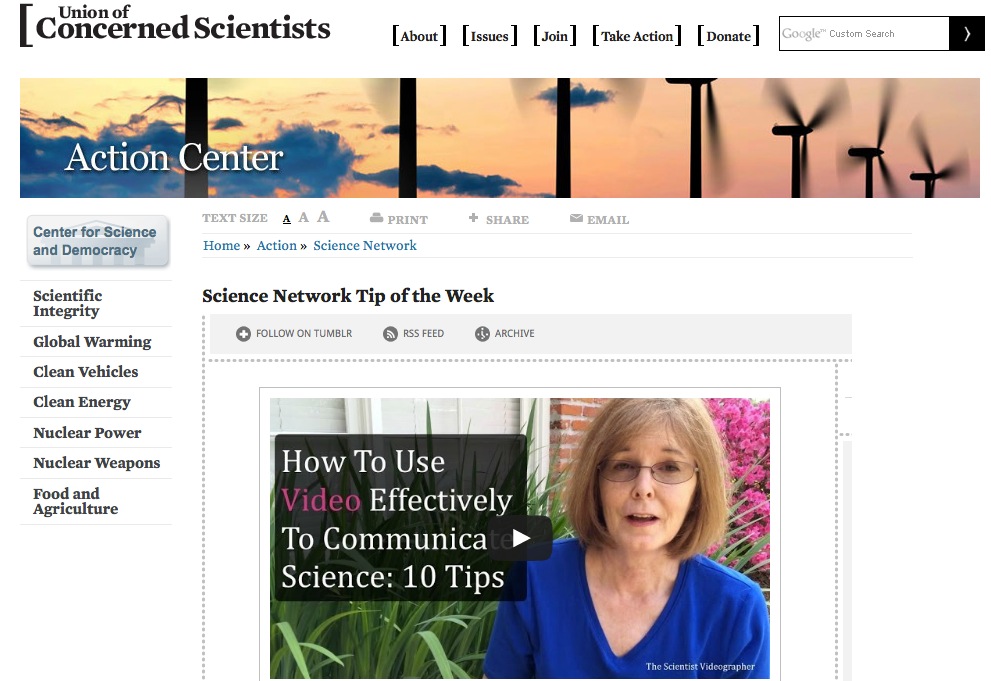I’ve heard that Jill Bolte-Taylor practiced her TED talk (My Stroke of Insight) 200 times. Was it worth the effort? Apparently so. Her talk has been viewed over 15 million times–one of the most popular on the TED website. Of course, her compelling story about suffering a stroke at the age of 37 and her thoughts about it from the viewpoint of a neuroanatomist had something to do with its immense popularity. However, her delivery was spell-binding. And that required a great deal of planning, effort, and, yes, practice.
I give this example to make a point or two about practicing your science talks and to make a suggestion about how to improve your performance.
Those of us in science often practice our conference talks and seminars only in our heads—rarely out loud—you know who you are. And it shows. The last conference I attended was filled with the usual boring, rambling, droning presentations that often went overtime, and my thought, sitting in the audience, was that these presenters probably had no idea how terrible they sounded. They probably thought their presentations were fine, perhaps even brilliant. Who’s going to tell them otherwise? “Hey, Professor Hotshot, your talk sucked!”
Students are told to practice, practice, practice their talks. Some do, but many try to emulate their professors—the ones who put their slides together the night before their session and then just wing it. Of course, the professor has a lot more experience speaking extemporaneously and also can get away with giving a bad talk occasionally. A student or early-career scientist cannot afford to take chances—especially in a high-stakes situation like a job interview seminar. In fact, it is just such a situation that a speaker must be well-practiced. An outstanding talk may be the main factor distinguishing the successful job candidate from the rest of the pack. The speaker not only must have internalized the talk’s content, but their voice, facial expressions, and body language should exude confidence, not nervousness or uncertainty.
So, how do you know if your talk is good or still needs some more practice? Well, how many professional talks have you given? One or two? If so, you probably need more practice than someone who has given fifty talks. If you consider yourself an experienced speaker, do people routinely tell you afterwards that your talk was great—without any prompting from you? No? Then perhaps some change is in order.
How can you assess the effectiveness of a particular presentation or, more generally, your speaking skills?
The typical advice is to give the talk to a group of friends or colleagues—several times, if possible. This is a good idea, especially for novices or anyone planning to deliver a high-stakes talk. However, this approach may not be possible or always convenient. We also may be reluctant to impose on others. Even when some speakers do get feedback, they fail to act on the suggestions because they don’t believe (or don’t want to believe) that their performance is less than stellar.
The other, less common, advice is to use video to record a speaker’s performance. I’ve found that students can especially benefit from watching videos of their speeches—particularly students who won’t accept critical comments from the audience. Actually seeing themselves fidgeting, mumbling, or rocking back and forth makes it difficult to deny what others are telling them. Often, observing themselves on camera is a great eye-opener, even for a seasoned speaker. So I think it’s a great idea to video yourself giving your presentation and then watch it to see where it needs improvement. This approach literally puts you in the audience’s shoes. You can see how you and your presentation will look to others. Is it understandable? Are there parts that are too fast, too slow? Is your voice clear and steady or squeaky and annoying? Are you using inappropriate gestures or standing like a statue? What overall impression does your body language and voice convey?
Some will balk at the advice to practice out loud and especially to use video to review their performance. “It’s too much work.” “I don’t have time–my talk is next week and I still don’t have my slides prepared!” “My delivery is fine; I don’t need to see a video to know this.” Well, I can tell you from watching videos of my talks that my perception of how well (or not) I was doing during the talk did not necessarily agree with what I saw on tape later. If you’ve never seen yourself giving a talk, then you may be in for a big surprise. You might discover that you have a distracting mannerism or that your body language says, “I don’t have a clue what I’m doing.” You might see that you spend too much time looking at your slides instead of the audience. Your voice may be a droning monotone that puts people to sleep. These are all problems of delivery that practice can help. And video can help you see what those problems are and whether you are improving with practice.
I’m surprised more people don’t use video to practice and improve their talks. Unlike when I was a student, making a video today is as easy as pulling out your cell phone. Modern smartphones have excellent video cameras, and you can use one to record and review your science talks. Here are a few tips:
1. To practice speaking, the idea is to simulate the conditions you’ll experience during the real talk as closely as possible. Stand up in front of your slides and deliver your talk out loud. Use a remote control to advance your slides; practice with a laser pointer if you plan to use one.
2. You might record your presentation in a small conference room that has a projector and screen. If that is not possible, then you’ll have to improvise in an office, laboratory, or at home. If you don’t have access to a projector, it may be possible to mirror your presentation on a TV screen. If you have Apple TV, you’ll be able to do this easily.
3. Try to stabilize your video recording device on a tripod, desk, shelf, or table and position it a sufficient distance away from you to film your entire body (or most of it).
4. If you use a phone or tablet as a recording device, be sure to position it in landscape orientation to record video.
5. It’s advantageous to have an audience for at least one of your practice videos because you want to record how well you make eye contact with audience members and also how you handle questions. If this is not possible, you might pin up photographs of people’s faces around the room to simulate an audience.
6. You might find it convenient to film your practice presentation in short segments instead of one long recording. This way, you can more easily review specific parts without having to wade through the entire film—especially if your talk is an hour long. You could divide the film, for example, at natural breaks: background/introduction, methods, results, discussion, and conclusions.
7. Review your video with a critical eye and ear for timing, body language, gestures, facial expressions, eye contact, and voice. If you spot a problem, try to figure out when and why it occurs, which may help you address it. For example, you may um and ah a lot whenever you get to information that you’re less confident about. Perhaps you need to rethink what you want to say so that you are more certain.
8. You may have to watch your video performance several times to let the initial shock (of seeing yourself as others do) wear off. However, you will become accustomed to seeing and hearing yourself on film and be able to watch critically.
9. It also helps to watch your video performance with someone else who can help you spot problems and to make suggestions for improvement. Students could work together to review each others’ videos, for example. You also could share your practice video with an advisor or some other mentor who may not have been able to hear the talk in person. Perhaps they are on sabbatical or doing fieldwork, but you really want their input. They can review the video and give you some additional feedback.
10. Courses designed to teach students how to give a scientific presentation would greatly benefit from having some or all of the talks recorded on video and reviewed by the instructor and classmates.
Very few people are naturally gifted speakers. Most of us have to work at it, but It’s difficult to improve if you have no idea of what you are doing wrong. Recording yourself with video can be an easy way to identify and correct problems.






